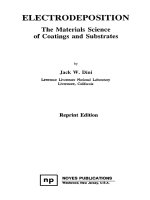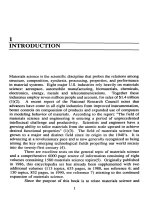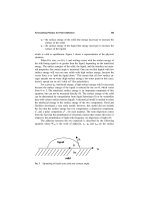The Materials Science of Coatings and Substrates Part 1 ppt
Bạn đang xem bản rút gọn của tài liệu. Xem và tải ngay bản đầy đủ của tài liệu tại đây (1.55 MB, 25 trang )
1
INTRODUCTION
Materials science is the scientific discipline that probes the relations among
structure, composition, synthesis, processing, properties, and performance
in material systems. Eight major
U.S.
industries rely heavily on materials
science: aerospace, automobile manufacturing, biomaterials, chemicals,
electronics, energy, metals and telecommunications. Together these
industries employ seven million people and account,
for
sales of
$1.4
trillion
(1)(2).
A
recent report of the National Research Council notes that
advances have come in all eight industries from improved instrumentation,
better controls on composition of products and expanded use of computers
in modeling behavior
of
materials. According to the report: "The field
of
materials science and engineering is entering a period of unprecedented
intellectual challenge and productivity. Scientists and engineers have a
growing ability
to
tailor materials from the atomic scale upward
to
achieve
desired functional properties"
(1)(3).
The field of materials science has
grown
to
a major and distinct field since its origin in the
1940's.
It
is
advancing at a revolutionary pace and is now generally recognized as being
among the key emerging technological fields propelling our world society
into the twenty-first century
(4).
There are excellent texts on the general topic of materials science
and a comprehensive
6000
page source of information consisting of eight
volumes containing
1580
materials science topics(5). Originally published
in
1986,
this encyclopedia set has already been supplemented with two
additional yolumes
(113
topics,
653
pages, in
1988,
see reference
6;
and
130
topics,
832
pages, in
1990,
see reference
7)
attesting
to
the continued
expansion of materials science.
Since the purpose of this
book
is
to
relate materials science and
1
2
Electrodeposition
electrodeposition some brief history is in order. The 1949 text by Blum and
Hogaboom
(8)
presents some of the principles of materials science even
though it was not
so
named at that time.
The book contains a number of
photographs of structures of electrodeposits and data on properties. In the
1960's Read extended
this
coverage by showing the remarkable range of
structures and properties that can
be
achieved by electrodepositing a given
metal in a variety
of
ways
(9,lO).
In
more recent times (1982 and 1984)
Weil introduced the topic of materials science of electrodeposits disclosing
how
the
principles
of
materials science can be used to explain various
structures
of
electrodeposits and how these structures influence properties
(11,12).
As
Weil stated: "The understanding that has been gained
is
to
a
great extent responsible for changing plating from
an
art to a science"
(1
1).
Safranek's treatises on properties of deposits (1974 and 1986) are also very
valuable resources (13)(14). These two volumes contain property data from
over
lo00
technical papers.
COMMENTS
ON
ELECTRODEPOSITION
Electrodeposition is an extremely important technology. Covering
inexpensive and widely available base materials with plated layers of
different metals with superior properties extends their use to applications
which otherwise would have been prohibitively expensive (15). However,
it
should be noted that electroplating is not a simple dip and dunk process.
It
is probably one of the
most
complex unit operations known because of
the
unusually large number of critical elementary phenomena
or
process
steps which control the overall process (16).
An
excellent example is the
system model from Rudzki (Figure 1) for metal distribution showing the
interrelation of plating variables and their complexity (17).
Figure 2 is a
simplified version summarizing the factors that influence the properties of
deposits. Electrodeposition involves surface phenomena, solid state
processes, and processes occurring in the liquid state, thereby drawing on
many scientific disciplines as shown in Table 1
(15).
FACTORS AFFECTING COATINGS
It
has been suggested that three different zones: 1) the substrate interface,
2) the coating, and 3) the coating-environment interface have to be
considered when protecting materials with coatings (18). These, plus a
fourth zone- the substrate, are covered in sequential fashion in the following
chapters. Figure 3 shows these zones along with the titles of the chapters.
Introduction
3
Figure
1:
System model illustrating metal distribution relationships.
From
Reference
17.
Reprinted wilh permission
of
ASM International, Metals
Park,
Ohio.
4
Electrodeposition
System components
Tank
Electrodes
Solution composition
Process conditions
Current
Factors influencing
metal distribution Electrodeposit
Geometric
Electrochemical
Incidental
Metal distribution
Composition
Structure
Properties
Figure
2:
Metal distribution relationships
in
electrodeposition.
Table
1:
Interdisciplinary nature
of
Electrodeposition*
Involvement
Electrochemistry Electrode processes
Elecuochemical engineering Transport phenomena
Surface science Analytical tools
Solid state physics
Metallurgy and materials
science
Use
of
quantam mechanical
solid state concepts to study
electrode processes
Properties of deposits
Electronics Modern instrumentation
*
From Reference
15.
Introduction
5
Figure
3:
Important criteria when selecting coatings. This also is a listing
of
the
following chapters in this
book
starting with HYDROGEN EMBRIT-
TLEMENT and proceeding through to WEAR.
6
Electrodeposition
First is the substrate where potential hydrogen embrittlement effects are of
concern. The second zone is the basis metal interface where adhesion
of
the
coating and interdiffusion between the coating and substrate are of
importance. The third zone is the coating itself where composition and
microstructure determine properties and factors such as stress, phase
transformations and grain growth exert noticeable influences.
The final
zone is the environmental interface where the interaction of the coating in
its intended application has to be considered in terms of corrosion and/or
wear.
Clearly, many of the items
are
important in more than one zone.
For example; porosity and/or stress in the substrate (rather than just in the
coating)
can
noticeably influence coating properties; porosity can noticeably
affect corrosion resistance and tensile properties; hydrogen embrittlement is
a factor not only for substrates but also for some coatings; and diffusion
of
codeposited alloying impurities to the surface can noticeably affect wear and
corrosion properties.
For
reasons such
as
these,
many
of
the topics
are
discussed interchangeably throughout the book.
The chapter on HYDROGEN EMBRI'ITLEMENT concentrates
heavily
on
steels since these substrates are particularly susceptible to
damage by hydrogen. This chapter also covers permeation of hydrogen
through various protective coatings, hydrogen embrittlement
of
electroless
copper deposits and hydrogen concerns as a result
of
chemical milling.
The importance of ADHESION is discussed in the next chapter and
this topic is broken down into four categories; interfacial adhesion,
interdiffusion adhesion, intermediate layer adhesion and mechanical
interlocking.
A
variety of quantitative tests for measuring adhesion are
discussed and then a methodology is presented for use when confronted
with difficult-to-plate substrates. Processes that have been used
to
provide
adhesion
of
coatings on difficult-to-plate substrates are discussed and
supported with quantitative data. The relatively new approach
of
combining
physical vapor deposition with electroplating which offers considerable
promise for obtaining adherent bonds between coatings and difficult-to-plate
substrates is also covered. Other techniques such as interface tailoring,
alloying surface layers with metals exhibiting a high negative free energy
of formation, use
of
partial pressure
of
various gases during deposition,
reactive ion mixing and phase-in deposition are also discussed.
DIFFUSION, which is the attempt
of
a system
to
achieve equilibri-
um through elimination
of
concentration gradients, can result in degradation
of
properties and appearance. Diffusion mechanisms are discussed with
particular emphasis placed on Kirkendall voids which can lead
to
loss of
adhesion. Diffusion is influenced by the nature of the atoms, temperature,
concentration gradients, nature of the lattice crystal structure, grain size,
amount
of
impurities and the presence
of
cold work
(19).
An effective way
Introduction
7
to minimize
or
eliminate potential diffusion problems is the use
of
barrier
coatings.
In
some instances, diffusion can benefit coating applications.
Examples include deposition of alloy coatings and diffusion welding which
utilizes diffusion
to
produce high integrity joints in a range
of
both similar
and dissimilar metals.
Although PROPERTIES are discussed throughout the book, this
chapter is included to cover some specifics not covered elsewhere. Topics
include tensile property measurements, strength and ductility of
thin
deposits,
the
Hall-Petch relationship between strength and grain size, and the
influence
of
impurities
on
properties. Superplasticity, which refers
to
the
ability of a material
to
be
stretched to many times its original length, is
covered since electrodeposition offers some potential in this area.
STRUCTURE is one of the longest chapters in the book and
rightfully
so
since structure is
so
dominant a factor
in
materials science.
The variety
of
structures obtainable with electrodeposits are discussed and
illustrated,
as
is the influence of substrate
on
coating structure. Phase
transformations, which can noticeably affect deposit properties, are reviewed
for electroless nickel, gold-copper, tin-nickel, palladium and cobalt deposits.
Microstructural stability
of
copper and silver deposits at room temperature
is
also covered. Texture of deposits is an important structural parameter for
bulk materials and coatings and a good illustration of how properties can
be
tailored for applications such as formability, corrosion resistance, etching
characteristics, contact resistance, magnetics, wear resistance, and porosity.
Fractals, which offer the materials scientist a new way to analyze micro-
structures, provide a new tool for studying surfaces and corrosion processes.
Some concepts
of
fractals are presented as are examples
of
results already
obtained with various surfaces.
ADDITIVES are included as a separate chapter because of their
extreme importance
on
the structure and properties of deposits. Some
of
the
folklore regarding addition agents is discussed and examples included
illustrating the interesting history of this complex aspect of electrodeposi-
tion. Data are presented showing the influence of additives
on
tensile
properties, leveling, and brightening.
Typical additive systems used for
deposition of a variety of deposits are reviewed as are proposed mechanisms
of additive behavior. Control of addition agents via techniques such as the
Hull cell, bent cathode, electroanalytical techniques, chromatography and
other analytical methods is covered in some detail.
POROSITY is one of the main sources of discontinuities in
electrodeposited coatings. It can noticeably inhence corrosion resistance,
mechanical properties, electrical properties and diffusion characteristics.
Items which influence porosity include the substrate, the plating solution
and its operating characteristics, and post plating treatments.
An
effective
way to minimize porosity is to
use
an underplate.
Another
is
to
deposit
8
Electrodeposition
coatings with specific crystallographic orientations which can strongly
influence covering power and rate
of
pore closure. A variety
of
porosity
tests are available for testing coatings and these are discussed in some
detail.
STRESS in coatings can also adversely affect properties.
A
variety
of
options are available for reducing deposit stress and these include: choice
of
substrate, choice of plating solution, use of additives and use
of
higher
plating temperatures.
A
variety of theories have been postulated regarding
the origins of stress but none of them covers all situations. Numerous stress
measurement techniques are available and they
vary
from the simple rigid
strip technique
to
sophisticated methods using holographic interferometry.
CORROSION
is
affected by a variety
of
factors including
metallurgical, electrochemical, physical chemistry and thermodynamic.
Since all of these encompass the field
of
materials science, the topic of
corrosion is essentially covered in many places in this book other than this
particular chapter. Often it is difficult to separate corrosion from many
of
the other property issues associated with deposits. When selecting a coating
it
is
important to know its position with respect to its substrate in the
galvanic series for the intended application. Besides galvanic effects, the
substrate and the interfacial zone between
it
and the coating can noticeably
affect the growth and corrosion resistance of the subsequent coating since
corrosion is affected by structure, grain size, porosity, metallic impurity
content, interactions involving metallic underplates and cleanliness or
freedom from processing contaminants
(20).
Decorative nickel-chromium
coatings developed for automotive industry applications are a good example
of use of materials science and electrochemistry to improve corrosion
resistance properties.
WEAR, like corrosion, does not
fit
handily within the confines of
a traditional discipline. Physics, chemistry, metallurgy and mechanical
engineering all contribute to this topic. A particular feature of electrode-
position that is attractive for wear applications is its low temperature
processing and ability to be applied to distortion prone substrates without
increasing stress in the composite. Mechanisms of wear are discussed as are
some of the more important tests used for evaluating wear characteristics.
Coatings that are used for various wear applications include chromium,
electroless nickel, precious metals and anodized aluminum. Recent
advances include ion implantation of chromium deposits with nitrogen
to
provide improved wear resistance and codeposition
of
dispersed particles
with electroless nickel. Microlayered metallic coatings also known as
composition modulated coatings also offer promise. Although electrode-
posited coatings are typically not effective at temperatures above
50O0C,
composite coatings containing chromium or cobalt particulates in a nickel
or cobalt matrix can
be
effective.
Introduction
9
REFERENCES
1.
2.
3.
4.
5.
6.
7.
8.
9.
10.
11.
Materials Science
and
Engineering for the 1990's-Maintaining
Competitiveness in the Age
of
Materials,
By the Committee
on
Materials Science and Engineering of the National Research
Council, P. Chaudhari and M. Flemings, Chairmen, National
Academy Press, Washington, D.C. (1989).
R. Abbaschian, "Materials Education-
A
Challenge",
MRS
Bulletin,
Vol XV,
No
8, 18 (Aug 1990).
P.
H.
Abelson, "Support
for
Materials Science and Engineering",
Science,
247, 1273
(16
March 1990).
A.
L.
Bement,
Jr.,
"The Greening of Materials Science and
Engineering",
Metallurgical Transactions
A,
18A,
363 (March
1987).
Encyclopedia of Materials Science and Engineering,
M.
B.
Bever,
Editor-in-Chief, Pergamon Press, Oxford, (1986).
Encyclopedia of Materials Science and Engineering,
Supplementary
Volume 1,
R.
W.
Cahn, Editor, Pergamon Press, Oxford, (1988).
Encyclopedia of Materials Science and Engineering,
Supplementary
Volume 2, R. W. Cahn, Editor, Pergamon Press, Oxford, (1990).
W. Blum and G. B. Hogaboom,
Principles of Electroplating and
Electroforming,
Third Edition, McGraw-Hill (1949).
H.
J.
Read, "The Effects of Addition Agents on Physical and
Mechanical Properties of Electrodeposits",
Plating,
49, 602 (1 962).
H.
J.
Read, "Metallurgical Aspects of Electrodeposits",
Plating
54,
33 (1967).
R. Weil, "Materials Science of Electrodeposits",
Plating
&
Surface
Finishing,
69, 46 (Dec 1982).
10
Electrodeposition
12.
13.
14.
15.
16.
17.
18.
19.
20.
R. Weil, "Relevant Materials Science for Electroplaters",
Electro-
plating Engineering Handbook,
Fourth Edition, L.
J.
Dumey,
Editor, Van Nostrand Reinhold,
(1989).
W.
H.
Safranek,
The Properties of Electrodeposited Metals
and
Alloys-A
Handbook,
American Elsevier Publishing
Co.
(1 974).
W.
H.
Safranek,
The Properties of Electrodeposited Metals and
Alloys,
A
Handbook, Second Edition,
American Electroplaters
&
Surface Finishers
Soc.,
(1986).
U.
Landau, "Plating-New Prospects for an Old Art",
Electrochemis-
try
in Industry, New Directions,
U.
Landau,
E.
Yeager and D.
Kortan, Editors, Plenum Press, New York
(1982).
V. A. Ettel, "Fundamentals, Practice and Control in Electrode-
position-An Overview",
Application
of
Polarization Measurements
in
the
Control
of
Metal Deposition,
I.
H. Warren, Editor, Elsevier,
Amsterdam
(1984).
G.
J.
Rudzki,
Surface Finishing Systems,
ASM, Metals Park, Ohio
(1983).
H.
Holleck, "Material Selection for Hard Coatings",
J.
Vac. Sci.
Technol.,
A4(6), 2661
(Nov/Dec
1986).
"Diffusion and Surface Treatments", Chapter
13
in
Elements of
Metallurgy,
R.
S.
Edelman, Editor, ASM, Metals Park, Ohio
(1963).
R. P. Frankenthal, "Corrosion in Electronic Applications", Chapter
9
in
Properties of Electrodeposits, Their Measurement ana'
Significance,
R. Sard, H. Leidheiser,
Jr.,
and
F.
Ogburn, Editors,
The Electrochemical
SOC.
(1 975).
2
HYDROGEN
EMBRITTLEMENT
Electrodeposition and electroless deposition and their associated
processing steps including acid pickling and electrocleaning can generate
hydrogen which can enter substrates in the atomic form and cause hydrogen
embrittlement.
This
chapter outlines the factors which cause hydrogen
embrittlement, its subsequent effects and failure mechanisms, and then
elaborates
on
methods for reducing
or
eliminating the problem. Since steels
are particularly prone to hydrogen embrittlement, emphasis is placed on
these alloys.
A
section
on
permeation
of
hydrogen through various
protective coatings is included to show the effectiveness of various barrier
layers on minimizing hydrogen egress to substrates. Some excellent
materials science investigative work showing how electroless copper
deposits are embrittled by hydrogen is also presented along with data on
hydrogen pick-up
as
a result of chemical milling
of
various steel and
Hydrogen embrittlement is a generic term used to describe
a
wide
variety of fracture phenomena having
a
common relationship to the presence
of hydrogen in the alloy as a solute element
or
in the atmosphere as
a
gas
(1).
Louthan (2) lists the following problems as
a
result of hydrogen
embrittlement and/or hydriding: failures of fuel cladding in nuclear
reactors, breakage of aircraft components, leakage from gas filled pressure
vessels used by
NASA,
delayed failure in numerous high strength steels,
reductions in mechanical properties of nuclear materials, and blisters or
fisheyes in copper, aluminum and steel parts. Steels, particularly those with
high strengths of 1240 to 2140 MPa (180,OOO to
310,000
psi) are prone to
hydrogen embrittlement regardless of temperature (3)(4), (Figure
1).
However, hydrogen embrittlement is not specific to just high strength steels.
titanium alloys.
11
12
Electrodeposition
Figure
1:
Fracture stress as a function of hydrogen absorption and
temperature for
0.08%
carbon steel. From reference
4.
Reprinted with
permission of
ASM.
Nickel, titanium, aluniirium
(4)(5)
and even electroless copper deposits
(6)
exhibit the phenomenon.
It
appears that any material can become embrittled
by a pressure
effect
if
hydrogen bubbles are introduced by a means such
as
electrodeposition and
this
state remains unchanged until hydrogen atoms
escape from the bubbles
(6).
In
some cases, the failure can
be
so
abrupt
and forceful as to seem almost explosive
(7).
Geduld reminisced that "one
of the most spectacular and memorable sounds associated with zinc plating
was standing
in
a quiet storage room next to
drums
of recently zinc plated
steel springs and listening to the metallic shriek of self-destruction.
as
the
springs slowly destroyed themselves in order to release occluded hydrogen"
Some examples of the effects
of
hydrogen on the structure of metals
are shown in Figures
2
through
10.
Figure
2
is a photomicrograph of
commercial copper that had been heated in hydrogen. The treatment
produced a porous, degenerated structure of low strength and ductility.
Figure
3
shows the wall of a heavy pressure vessel used in the
petrochemical industry that developed large internal blisters and cracks from
(8).
Hydrogen Embrittlement
13
the action of hydrogen
as
a
result
of
sulfide corrosion. Figure
4
shows
a
vanadium wire that literally shattered when it was cathodically charged with
hydrogen in
an
electrolytic cell
(9).
Figures
5
through
10
show the influence of hydrogen on steel
(10).
Figures
5
and 7 are a bar that was not cathodically treated, therefore, was
not hydrogen embrittled. The same bar is shown
in
Figures
6
and
8
after
cathodic treatment to introduce hydrogen and the severe damage is clearly
evident. Figure
9
is a cathodically treated specimen showing partial relief
as a result of heating at 200OC for
5
minutes while Figure
10
shows a
sample exhibiting full relief
as
a result of heating at 200OC
for
1
hour.
Figure
2:
Structure of commercial copper after heating
in
hydrogen
for
3
hours at 75OOC (about
250
X).
From reference
9.
Reprinted with
permission of Science.
14
Electrodeposition
Figure
3:
Hydrogen blisters in the wall
of
a steel container. From refere-
nce
9.
Reprinted with permission
of
Science.
Figure
4:
Vanadiuni
wire shattered by cathodic charging
with
hydrogen.
From reference
9.
Reprinted
with
permission
of
Science.
Hydrogen Embrittlement
15
Figure
5:
Steel sample
with
no cathodic treatment
(x
1).
From reference
10.
Figure
6:
Steel sample after cathodic treatment
(x
1).
From reference
10.
16
Electrodeposition
Figure
7:
Steel sample with
no
cathodic treatment
(x
3).
From reference
10.
Hydrogen Embrittlement
17
Figure
8:
Steel sample after cathodic treatment
(x
3).
From reference
10.
18
Electrodeposition
Figure
9:
Steel sample after cathodic treatment
than
heating at
200°C
for
five minutes
(x
3).
From
reference
10.
Hydrogen Embrittlement
19
Figure
10:
Steel
sample
after
cathodic
treatment
then
heating
at
200°C
for
one
hour
(x
3).
From reference
10.
20
Electrodeposition
Platers must
be
especially aware of hydrogen embrittlement effects
since many preplating and plating operations can
be
potent sources of
absorbable hydrogen. Table
1,
which lists sources of hydrogen, clearly
shows that cathodic cleaning, pickling and electroplating are all culprits.
This
table
also
shows why anodic cleaning, which generates no hydrogen,
is preferable to cathodic cleaning which generates copious amounts
of
hydrogen. Since corrosion reactions are also generators
of
hydrogen, care
in
choosing the proper coating
to
prevent corrosion is also quite important.
In
general, any process producing atomic hydrogen at a metal surface will
induce considerable hydrogen absorption in that metal. However, not all the
hydrogen atoms released at
the
surface enter metals; a large fraction com-
bines
or
recombines to form bubbles of gaseous or molecular hydrogen
which is
not
soluble in metals
(9).
MECHANISM
A
variety of mechanisms have been proposed to explain hydrogen
embrittlement.
In
fact within a given system, depending on the source of
hydrogen and the nature of the applied stress, the mechanism may change.
The following are suggested by Birnbaum
(1):
"Non-hydride forming
systems such as iron and nickel alloys which do not form hydrides under
the conditions in which they are embrittled fail because hydrogen decreases
the atomic bonding (decohesion). In many of these systems the fracture
seems to
be
associated with hydrogen-induced plasticity in the vicinity of
the crack tip. Metals such as niobium, zirconium, or titanium, which can
form stable hydrides, appear
to
fracture by a stress-induced hydride
formation and cleavage mechanism. Other mechanisms, such as adsorption-
decreased surface energy and high-pressure hydrogen gas bubble formation,
have also been suggested and may play a role
in
specific systems"
(1).
STEELS
Hydrogen embrittlement effects are most pronounced in steels.
These effects
can
take
the form of reduced ductility, ease of crack initiation
and/or propagation,
the
development of hydrogen-induced damage, such
as
surface blisters and cracks or internal voids, and in certain cases changes
in
the yield behavior
(1
1).
With
steels,
the problem
occurs
because of one or
more of four primary factors: temperature, microstructure, tensile stresses,
and hydrogen content
(12).
First, room temperature is just about right.
An
important consequence
of
the
ease of interstitial diffusion (which is the way
hydrogen moves about lattices) is the fact that considerable diffusion can
Hydrogen Embrittlement
21
Table
1:
Sources
of
Hydrogen
ACID TYPE CORROSION
Fe
+
2HC1-+ FeCI,
+
H,
ELECTROCHEMICAL CLEANING
ANODE REACTION
4
(OH)
-
4e
+
2HZO
+
0,
CATHODE REACTION
4H+
+
4e
+
2H,
PICKLING
ACID
+
METAL
-+
SALT
+
H,
ELECTROPLATING
CATHODE REACTIONS
Ni+*
+
2i5
-+
Ni METAL
2H'
+
2e-
+
H,
CONTAINMENT VESSELS FOR H,
REMNANTS
OF
DRAWING LUBRICANTS
DAMPNESS
IN MOLDS
DURING
CASTING
HUMIDITY
IN
FURNACES DURING HEAT TREATING
22
Electrodeposition
occur rather quickly even at low temperatures, in fact, even at room
temperature.
This
is one of the circumstances which can lead to hydrogen
pickup by metals during aqueous metal finishing operations at the
comparatively low temperatures which comprise
the
range in which water
is a liquid
(13).
Secondly, the microstructure of the plated part must be
susceptible
to
the cracking mechanism
and
the martensite, bainite, and fine
pearlite of quenched and tempered and cold drawn steels can allow the
cracking mechanisms to operate at hardnesses down to Rockwell
C
24
and
lower. Third, tensile stresses are required and even
if
the part is loaded in
compression, tensile stresses can develop and cracks will grow
perpendicular to these local tensile stresses. Fourth, a certain amount of
hydrogen is required
(12).
PREVENTION
OF
HYDROGEN EMBRITTLEMENT
The prevention of hydrogen embrittlement failure requires a
multi-pronged approach
1.
Prevention of hydrogen absorption wherever possible.
2.
Elimination
of
the residual stress
in
the part before processing.
3.
Baking after processing
to
remove absorbed hydrogen before
it
can damage the part.
Although beyond the control of
the
plater, hydrogen absorption can
occur because of dampness in molds during casting or from humidity in
furnaces during manufacture of the alloy. Baking parts before plating can
help
minimize
stresses and remove absorbed hydrogen. Table
2,
a
recommendation under development by ASTM, suggests times and tempera-
Table
2:
Stress Relief Requirements for High Strength Steels (a)
Tensile Strength Temp. Time
MPa psi
"C
Hours
1OOo-1400
145,000.203,oOO
200-230
Minimum
3
1401
-1
800
203,000-261,000
200-230
Minimum
18
Over
1800
Over
267,000
200-230
Minimum
24
a. From reference
14.
Hydrogen Embrittlement
23
tures (14). Electropolishing before plating could also help; hydrogen entry
into
sensitive steels may
be
less than when the surface is stressed (15).
Shot peening before plating has also been shown
to
reduce or even prevent
the absorption of hydrogen
(7).
Other practical steps
to
minimize
hydrogen
embrittlement include
(16)(17):
-
Avoidance of cathodic cleaning, pickling or activation treatments
whenever possible, by use of alkaline soak cleaning and anodic cleaning.
-
Use of vapor degreasing or solvent cleaning
to
remove
the
bulk
of
grease, oil, or other contaminants before cleaning
in
aqueous solutions.
-
Use of mechanical means (such as tumbling, sand
,
or
grit
blasting, vapor blasting,
etc.)
for oxide and scale removal, rather than
pickling.
-
Use of inhibited acid pickling solutions. The inhibitors either cut
down on the amount
of
metal dissolved and thereby reduce the amount of
hydrogen generated
or
they can change conditions at the surface
so
that less
of the generated hydrogen enters the metal.
-
Use of low embrittling electroplating processes such as special
solution compositions and operating conditions which result in either a
lower pickup
of
hydrogen or in a deposit that allows easier removal of the
absorbed hydrogen during the baking treatment.
Examples include 1) use
of fluoborate or Cd-Ti instead
of
cyanide cadmium,
2)
if
using cyanide
cadmium, plating to a thickness of
5
pm, baking for
3
hours at 190°C
to
remove hydrogen, and then continuing plating
to
the required thickness, or
3) use
of
a more permeable metal such as nickel where possible since
hydrogen escapes through nickel far more easily than through zinc or
cadmium.
-
Use of coating techniques that avoid or minimize hydrogen
embrittlement; e.g., vacuum deposited coatings, mechanical plating, and
organic coatings.
-
Baking after coating to provide hydrogen embrittlement relief.
This is a standard practice for removing hydrogen from plated parts and
verified in Figure
11
which shows the effect
of
baking at 149OC on the
time-to-failure
of
notched specimens
of
4340 steel heat treated
to
a strength
level
of
1590
MPa (230,000 psi). Table
3
lists baking recommendations
suggested by
ASTM
(14).
24
Electrodeposition
Figure
11:
The effect
of
baking
at
149°C
011
the
hie-to-Failure at a given
level of applied stress
and
stress
ratio
of
notched specimens
of
4340
steel
heat treated
to
a strength level
of
158G
MPa
(230,000
psi). From reference
18.
Reprinted with permission of ASM
Table
3:
Baking After Plating Recominendations of ASTM
(a)
Tensile Strength Temp. Time
MPa
psi
OC
Hours
1m-1100 145,OOO-160,ooO
190-220
Minimum
8
1101-1200 160,000- 174,000
190-220
Minimum
10
120
1-1
300
174,OOO-l89,oOO
190-220
Minimum
12
1301 -1400
1
89,OOO-203,OOO 190-220
Minimum
14
1401-1500 203,OOO-218,ooO
190-220
Minimum
16
1501
-1
600 218,000-232,000
190-220
Minimum
18
1601-1700 232,000-247,000
190-220
Minimum
20
1701-1800 247,000-26
1
,OOO
190-220
Minimum
22
a.
From reference
14.
Hydrogen Embrittlement
25
Statistically designed screening experiments were conducted to
determine the significance of various parameters
on
the hydrogen content
of bright and dull cadmium plated
4340
steel after baking
(19)(20).
Five
variables were investigated: two plating batches, a delay between plating
and baking, a delay between baking and measuring, the humidity conditions
during
this
latter delay, and the baking time. Table
4
summarizes the data
and shows that for bright cadmium, only the baking time was sigmfkant
whereas with dull cadmium, the batch was
also
sigmfkant. The reason for
this is probably that small changes in concentrations
of
the solution
ingredients, especially carbonate, can have a significant effect on the nature
of
the deposit from a dull cadmium solution.
A
delay in baking of
24
hours
had
no
effect on the final hydrogen content.
Also,
the hydrogen concen-
tration was not altered
if
the specimens were held for a month at relative
humidities
of
up to
50%
after baking,
Table
4:
Plackett-Burman Results on Removal
of
Hydrogen From
Bright and Dull Cadmium Plated
4340
Steel (a)
Limits
Llrnits
Bright
Factor
Dull
ellect
-
-
-
Column Variable
xl
Platlng batch
21
0.087
12
x2
Time between plating
1
24
0.1
27
1
24
and baklng
(h)
x3
Baking
tlme
(h)
8
48
8
20
x4
Time between baklng
2
690
0.040
2
690
and measuring
(h)
x5
Rclatlve humidity
(“A)”
0
35
0.077
0
50
Minlmum
slgnllicant
lactor
elfect
(90%
confldence level)
0.230
Factor
ellect
-
0.038
0.065
0.005
0.093
“0%
=
deslccator;
35%
=
amblent;
50%
=
over saturated Na, Cr2
0,.
a. From reference
19.









